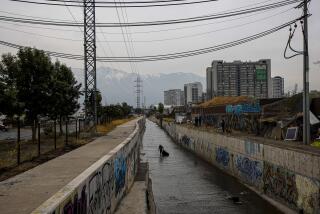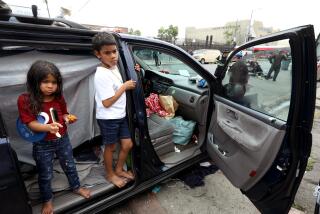Haven Helps Youths Leave Bogota Streets
- Share via
BOGOTA, Colombia — It was 8 a.m. at the Patio when Raul walked up, lifted his shirt and pulled out a piece of folded newspaper stuck in his pants that was covering a 10-inch cut on his stomach.
“It itches,” said the short, dark-haired boy with bright eyes, scratching the rough stitches that bind the incision the doctors made to repair a knife wound.
“I was selling dinner plates and other kitchen stuff and they robbed me and stabbed me here,” he said, pointing to the wound before asking for money for a cup of coffee.
Raul Mauricio Quintero is 17. He fought with his parents and went to live on Bogota’s streets.
He is but one of an army of an estimated 2,500 dirty children, clothed in rags, whose only home is the streets of Bogota. The children, mostly boys, are called gamines, or street urchins. They get their food from begging or stealing, and their escape is smoking basuco --a cheap, primitive form of cocaine.
Many of those roaming Bogota’s streets come from extremely poor families, who have little food to provide and whose homes are the sites of constant conflicts, said Manuel Ospina, director of the Patio, a facility for gamines.
“ Gamines is like a disease--it’s easy to catch,” he said, estimating that about 500,000 Colombian children have the potential to leave home to inhabit the streets.
But here, for some, is the beginning of hope. The Patio is the first step a gamin can take to get off the streets. The facility is part of a program founded in 1971 by the Rev. Javier de Nicolo, an Italian Roman Catholic priest.
Outside the Patio that day in the grimy center of the city gathered a platoon of ragtag boys. Most slept by the gate, curled up on the cement with only the tops of their heads sticking out of the tops of their rags.
Only a few years ago, Edgar Osorio Ruiz was among their numbers. He had been kicked out of his house at age 6 and spent six more years surviving.
“I robbed in order to take drugs, every kind of drug,” said Osorio.
Now Osorio is mayor of The Boys Republic, a boys town for gamines on the outskirts of the city that presents another step for those trying to leave the street. He, like the 180 other boys at the encampment of neat brick dormitories, classrooms and workshops, are neatly dressed and instantly ready to greet visitors with a handshake.
The boys come here after completing at least three years of living in a facility in the city where they have a bed, meals and attend elementary school.
Then if they chose to continue, they move to the boys town, leaving behind the vices of the streets. Those who violate the rules face not punishment by adults, but a talk with elected leaders such as Osorio.
“There is no physical punishment, no mental punishment,” said Osorio. “Everything is done by dialogue.”
Males ranging from youngsters to young adults of 20 scurry about the little village carrying mops to places they are assigned to clean. Others empty garbage cans. The place is spotless.
Classrooms are filled with the well-scrubbed faces of those learning woodworking, metal shop, ceramic work and how to wire a home for electricity. In another room, a group studies English and in still another, pairs of boys are eager to show how they can manipulate an Atari computer to produce a shape on a television screen.
For their work, the boys earn money called camellos, their own currency, that can be exchanged at a bank for real Colombian currency. There are movies on Saturday nights and occasionally a dance at a girls school.
“A mayor has to be very attentive, it requires a lot,” said Osorio. “You have to please the others.”
Javier Diaz, a priest and subdirector of the program, said boys who have graduated from the program have gone on to study at universities, including several who have received scholarships to U.S. schools.
More to Read
Sign up for Essential California
The most important California stories and recommendations in your inbox every morning.
You may occasionally receive promotional content from the Los Angeles Times.












